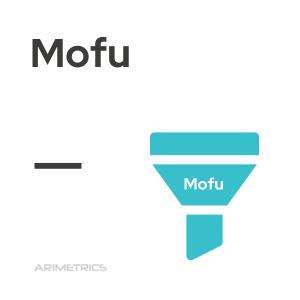
Definition:
The MOFU, or Middle of the Funnel, is the middle stage of the conversion funnel. At this stage, consumers have moved from simple awareness of their needs to actively considering solutions. Here, brands have the opportunity to deepen their relationship with consumers by providing information and value to guide them toward an informed purchase decision. The other parts are the TOFU (initial part) and the BOFU (final part).
What is MOFU used for?
The MOFU acts as an essential bridge between initial attraction and final conversion. At this stage, brands must demonstrate their ability to meet specific consumer needs, transforming interest into tangible engagement. In addition, MOFU helps to:
- Build trust and credibility: By providing educational and valuable content, brands reinforce their credibility with consumers.
- Guide consumers in their decision process: Provide product comparisons, customer testimonials and other resources that help consumers visualize how their needs can be met.
- Segmentation and personalization: Leverage the information gathered about consumers to segment them and deliver personalized experiences.
- Lead nurturing: Maintain consumer interest through targeted marketing campaigns, such as email marketing and retargeting.
- Education on the value of the offer: Clearly communicate the benefits and features of the products or services offered.
- Reducing uncertainty: Addressing common concerns and answering frequently asked questions, helping consumers move confidently to the purchase stage.
MOFU Objectives
At MOFU, brands seek to convert initial interest into more serious consideration. This involves several key objectives:
- Brand positioning: Brands must stand out as the right choice, clearly communicating their unique and differentiating value proposition.
- Lead generation: Convert interested visitors into qualified leads by collecting information in exchange for valuable content such as guides or exclusive access to resources.
- Consumer education: Providing detailed and useful information that helps consumers understand how products or services can solve their specific problems.
Strategies for MOFU
In the MOFU phase, it is crucial to implement strategies that not only inform, but also actively engage consumers, effectively guiding them through the conversion funnel. Tactics must be designed to educate, persuade and build trust, ensuring that consumers move toward conversion. Here are some key strategies:
- Interviews with experts: Offer high-value content through interviews with opinion leaders and industry experts, which brings credibility and authority to the brand.
- Tips and recommendations: Create content that offers practical solutions to common consumer problems, establishing the brand as a trusted source of information.
- Product demonstrations: Use videos and webinars to showcase product features and benefits, allowing consumers to visualize how they can meet their needs.
- Q&A: Develop content that addresses objections and frequently asked questions, helping to overcome barriers that may prevent conversion.
- Ebooks and in-depth guides: Publish comprehensive resources that position the brand as an industry leader, providing consumers with the information they need to make informed decisions.
- Identifiable testimonials: Present customer success stories that resonate with potential buyers, using real cases to demonstrate the value of the product or service.
- Authentic feedback: Encourage satisfied customers to share their experiences in a genuine way, which can positively influence new consumers.
- Email marketing campaigns: Implement targeted campaigns that include A/B and A/B/C testing to optimize content and segmentation. It is important to monitor open rates and CTR to adjust tactics and maximize impact.
- Social media campaigns: Use the advanced targeting capabilities of social platforms to reach specific audiences with social ads, seeking to encourage interaction and conversion.
- Retargeting: Using user behavior to personalize ads, increasing their effectiveness and driving users towards conversion.
